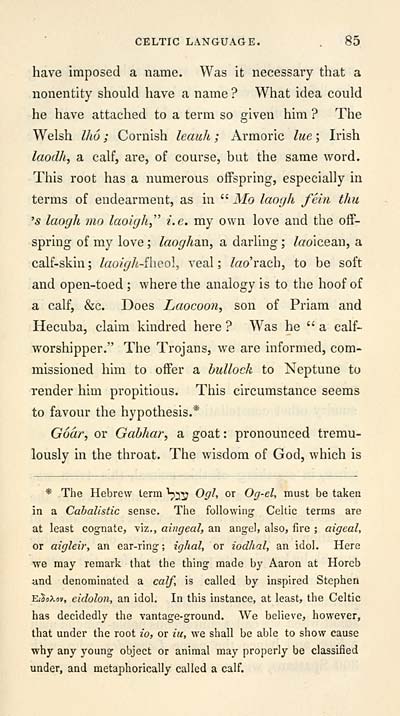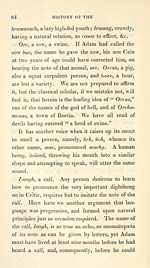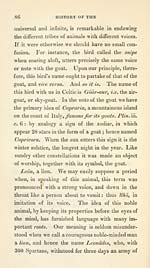Download files
Complete book:
Individual page:
Thumbnail gallery: Grid view | List view

CELTIC LANGUAGE. 85
have imposed a name. Was it necessary that a
nonentity should have a name ? What idea could
he have attached to a term so given him ? The
Welsh Iho ; Cornish leauh ; Armoric lue ; Irish
laodh^ a calf, are, of course, but the same word.
This root has a numerous offspring, especially in
terms of endearment, as in " Mo laogh fern thii
'5 laogh mo laoigJi^" i.e. my own love and the off-
spring of my love ; laogha,n, a darling ; lao'icean, a
calf-skin; laoigh-fheol, veal; /ao'rach, to be soft
and open-toed ; where the analogy is to the hoof of
a calf, &c. Does Laocoon, son of Priam and
Hecuba, claim kindred here ? Was he " a calf-
worshipper." The Trojans, we are informed, com-
missioned him to offer a bullock to Neptune to
render him propitious. This circumstance seems
to favour the hypothesis.*
Godr, or Gabhar, a goat: pronounced tremu-
lously in the throat. The wisdom of God, which is
* The Hebrew term "^y^ Ogl, or Og-el, must be taken
in a Cabalistic sense. The following Celtic terms are
at least cognate, viz., aingeal, an angel, also, fire ; aigeal,
or aigleir, an ear-ring; ighal, or iodhal, an idol. Here
■we may remark that the thing made by Aaron at Horeb
and denominated a calf, is called by inspired Stephen
E/SaXov, eidolon, an idol. In this instance, at least, the Celtic
has decidedly the vantage-ground. We believe, however,
that under the root io, or iu, we shall be able to show cause
why any young object or animal may properly be classified
under, and metaphorically called a calf.
have imposed a name. Was it necessary that a
nonentity should have a name ? What idea could
he have attached to a term so given him ? The
Welsh Iho ; Cornish leauh ; Armoric lue ; Irish
laodh^ a calf, are, of course, but the same word.
This root has a numerous offspring, especially in
terms of endearment, as in " Mo laogh fern thii
'5 laogh mo laoigJi^" i.e. my own love and the off-
spring of my love ; laogha,n, a darling ; lao'icean, a
calf-skin; laoigh-fheol, veal; /ao'rach, to be soft
and open-toed ; where the analogy is to the hoof of
a calf, &c. Does Laocoon, son of Priam and
Hecuba, claim kindred here ? Was he " a calf-
worshipper." The Trojans, we are informed, com-
missioned him to offer a bullock to Neptune to
render him propitious. This circumstance seems
to favour the hypothesis.*
Godr, or Gabhar, a goat: pronounced tremu-
lously in the throat. The wisdom of God, which is
* The Hebrew term "^y^ Ogl, or Og-el, must be taken
in a Cabalistic sense. The following Celtic terms are
at least cognate, viz., aingeal, an angel, also, fire ; aigeal,
or aigleir, an ear-ring; ighal, or iodhal, an idol. Here
■we may remark that the thing made by Aaron at Horeb
and denominated a calf, is called by inspired Stephen
E/SaXov, eidolon, an idol. In this instance, at least, the Celtic
has decidedly the vantage-ground. We believe, however,
that under the root io, or iu, we shall be able to show cause
why any young object or animal may properly be classified
under, and metaphorically called a calf.
Set display mode to: Large image | Transcription
Images and transcriptions on this page, including medium image downloads, may be used under the Creative Commons Attribution 4.0 International Licence unless otherwise stated. ![]()
| Early Gaelic Book Collections > Blair Collection > History of the Celtic language > (91) |
|---|
| Permanent URL | https://digital.nls.uk/76179610 |
|---|
| Description | A selection of books from a collection of more than 500 titles, mostly on religious and literary topics. Also includes some material dealing with other Celtic languages and societies. Collection created towards the end of the 19th century by Lady Evelyn Stewart Murray. |
|---|
| Description | Selected items from five 'Special and Named Printed Collections'. Includes books in Gaelic and other Celtic languages, works about the Gaels, their languages, literature, culture and history. |
|---|

